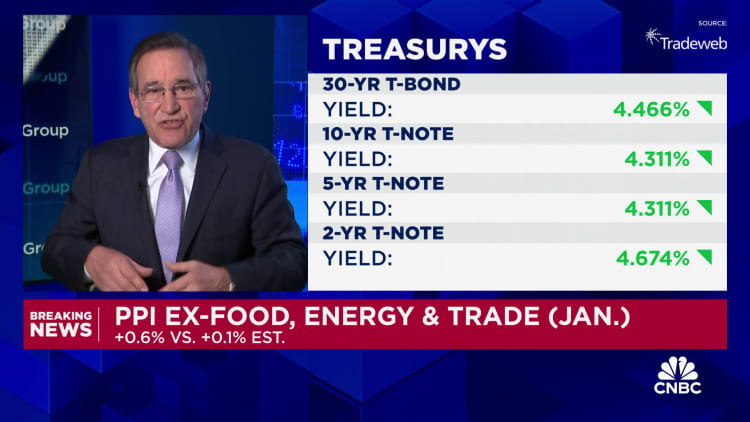
Wholesale prices rose more than expected in January, further complicating the inflation picture, according to a U.S. Department of Labor report Friday.
The producer price index, a measure of prices received by producers of domestic goods and services, rose 0.3% for the month, the biggest move since August. Economists surveyed by Dow Jones had been looking for an increase of just 0.1%. PPI fell 0.2% in December.
Excluding food and energy, core PPI increased 0.5%, also against expectations for a 0.1% gain. PPI excluding food, energy and trade services jumped 0.6%, its biggest one-month advance since January 2023.
The report comes just days after the consumer price index showed inflation holding stubbornly higher despite Federal Reserve expectations for moderation through the year. The CPI was up 3.1% from a year ago, down from its December level but still well ahead of the Fed’s goal for 2% inflation.
On a core basis, which the Fed focuses on more as a longer-term gauge of inflation, the CPI was up 3.9%. CPI differs from PPI in that it measures the prices consumers actually pay in the marketplace.
Markets fell sharply after Tuesday’s CPI reading, and there were fears that a hot PPI number also could cause another jolt. Expectations have been rising high that the Fed would use the easing inflation numbers as incentive to cut interest rates aggressively this year, but traders have had to pare back those expectations in recent days as inflation has shown unexpected persistence.
Stock market futures moved lower after the PPI report and Treasury yields surged.
Just a few weeks ago, markets had been pricing in the first Fed rate cut in March. That since has been pared back to June as policymakers have expressed caution about giving up the inflation fight too quickly while noting that an otherwise stable economy buys them time before having to move.
A 0.6% increase in final demand service helped propel the wholesale index higher, which in itself was boosted by a 2.2% rise in hospital outpatient care. Goods prices actually decreased 0.2% on the back of a 1.7% decline in final demand energy as gasoline slid 3.6%.
On a 12-month basis, headline PPI increased just 0.9%, slightly lower than the 1% level in December. However, excluding food, energy and trade services, the index rose 2.6%.
Along with the troublesome inflation readings, the Commerce Department reported this week that retail sales in January slid by 0.8%, far more than anticipated.
Don’t miss these stories from CNBC PRO:
Read the original article here
